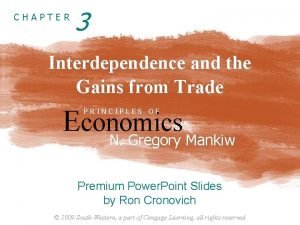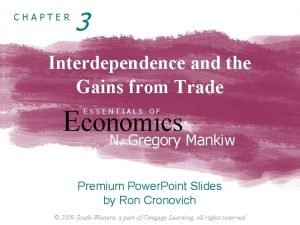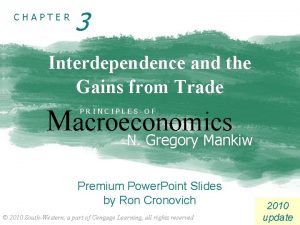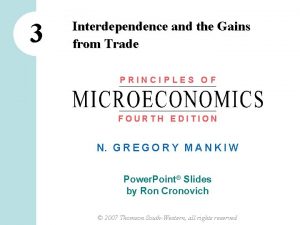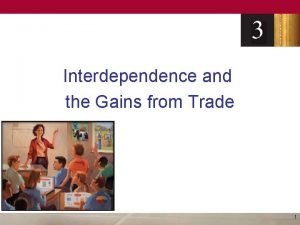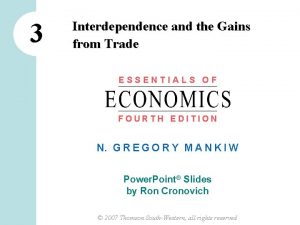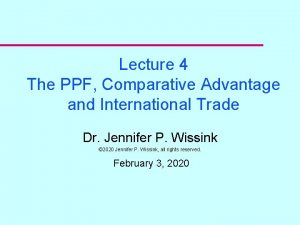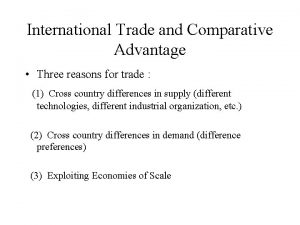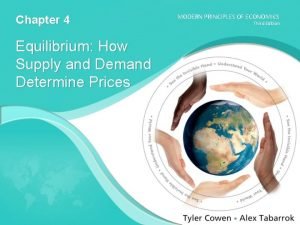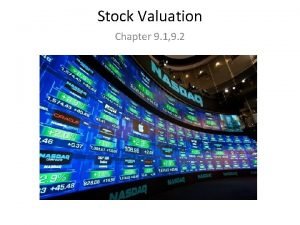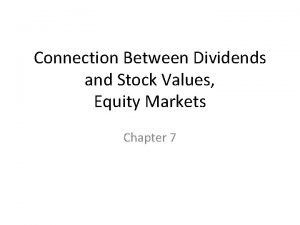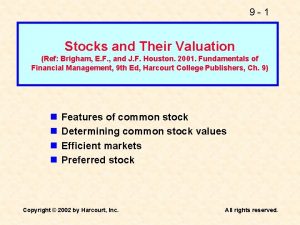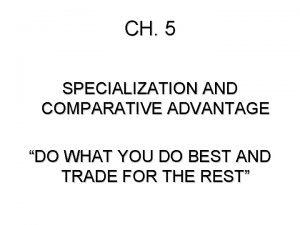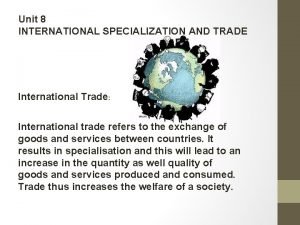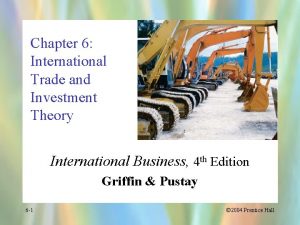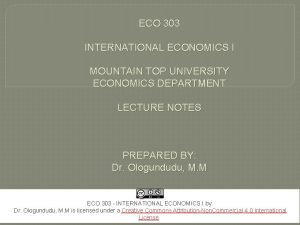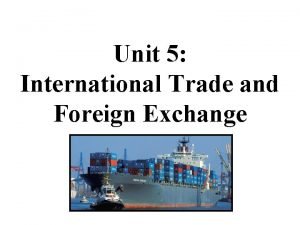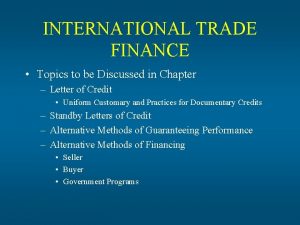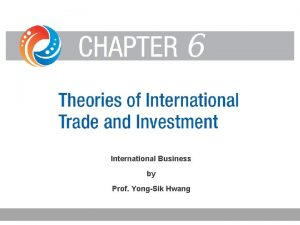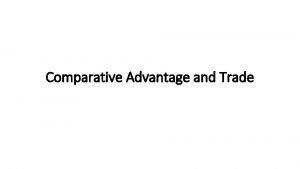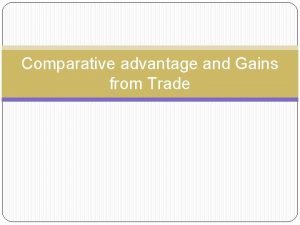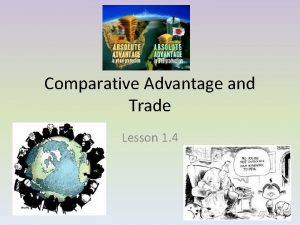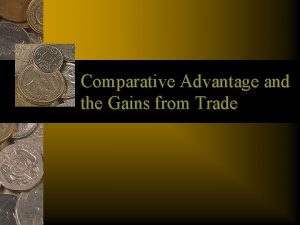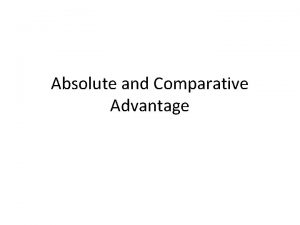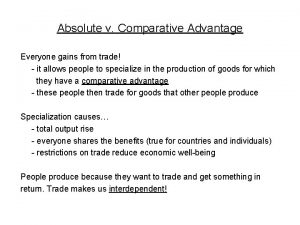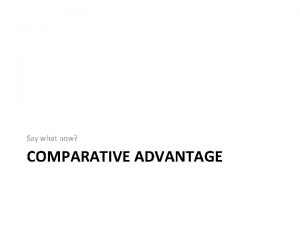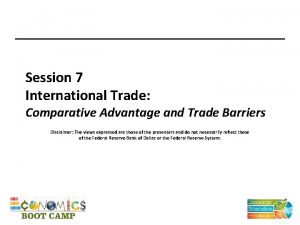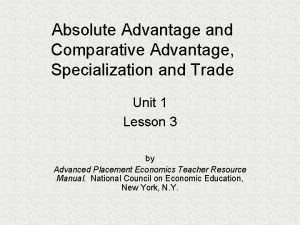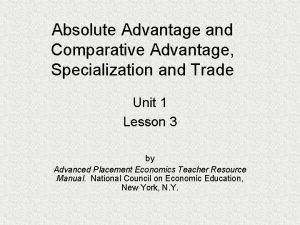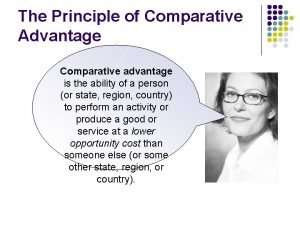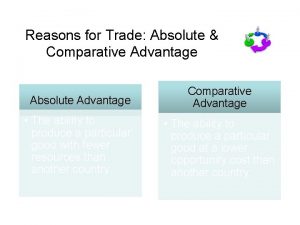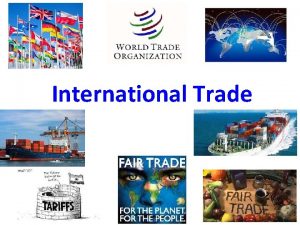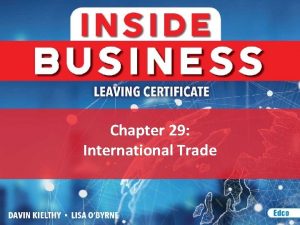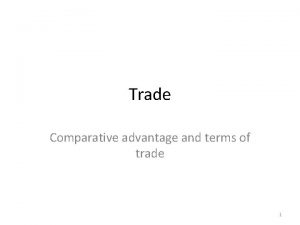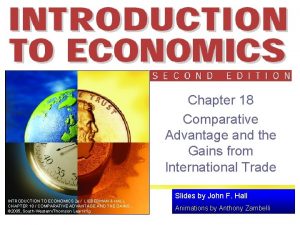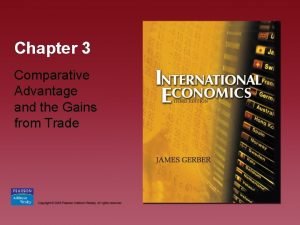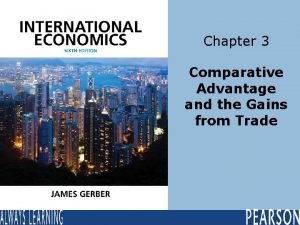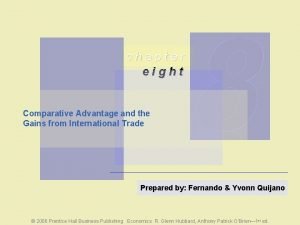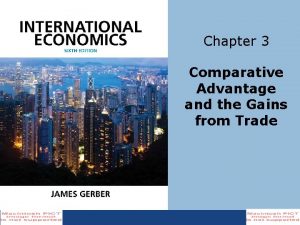Comparative Advantage and the Gains from International Trade




























- Slides: 28

Comparative Advantage and the Gains from International Trade Slides by: John & Pamela Hall ECONOMICS: Principles and Applications 3 e HALL & LIEBERMAN © 2005 Thomson Business and Professional Publishing

Comparative Advantage and the Gains from International Trade • Consumers love bargains • Should we let these bargain goods into the country? – Do cheap foreign goods threaten the jobs of American workers and the profits of American producers? • Over the post-World War II period, there has been a worldwide movement toward a policy of free trade – In 1995 a new international body was created • World Trade Organization (WTO) 2

Comparative Advantage and the Gains from International Trade • While many barriers have come down, others are being put up • Poor countries have imposed tariffs on computers, semiconductors, and software exported by rich countries – Rich countries have announced their intention to maintain existing quotas on textiles and clothing sold by poor countries • Is free international trade a good thing that makes us better off – Or is it bad and something that should be kept in check? 3

The Logic of Free Trade • Many of us like the idea of being self-reliant – But consider the defects of self-sufficiency • If you lived all by yourself, you would be poor • Defects of self-sufficiency explain why most people do not choose it • Principle applies not just to individuals, but also to groups of individuals – Such as those living within boundaries that define cities, countries, states, or nations • What would happen if residents of your state switched from a policy of open trading with other states to one of self-sufficiency – Refusing to import anything from “foreign states” or to export anything to them 4

The Logic of Free Trade • It would make no sense to insist on the economic selfsufficiency of each of the 50 states – Founders of United States placed prohibitions against tariffs, quotas, and other barriers to interstate commerce in U. S. Constitution • What is true for states is also true for entire nations – Members of WTO have carried argument to its ultimate conclusion • National specialization and exchange can expand world living standards through free international trade • Long-term goal of WTO is to remove all barriers to exports and imports – In order to encourage among nations specialization and trade that have been successful within nations 5

The Theory of Comparative Advantage • Economists who first considered the benefits of international trade focused on a country’s absolute advantage – A country has an absolute advantage in a good when it can produce it using fewer resources than another country • In 1817, however, British economist David Ricardo disagreed – A nation has a comparative advantage in producing a good if it can produce it at a lower opportunity cost than some other country • Mutually beneficial trade between any two countries is possible whenever one country is relatively better at producing a good than the other country – Being relatively better means having ability to produce a good at a lower opportunity cost • At a lower sacrifice of other goods foregone 6

Opportunity Cost and Comparative Advantage • To illustrate Ricardo’s insight, let’s consider a hypothetical world of two countries—China and United States • Both countries can gain from trade – If China could be persuaded to produce more suits and United States more computers • World’s total production of goods will increase – Each country can come out ahead by trading with the other 7

Specialization and World Production • Additional production is the kind of gain that, multiplied a million times, lies behind the substantial benefits countries enjoy from free trade • If countries specialize according to comparative advantage, a more efficient use of given resources occurs • That is, with the same resources, the world can produce more of at least one good – Without decreasing production of any other good 8

How Each Nation Gains From International Trade • By trading some of its comparative advantage good for the other good, each country can consume more of both goods • As long as such benefits continue, a country can gain even greater benefits by shifting more and more of its resources toward its comparative advantage good – As long as opportunity costs differ, specialization and trade can be beneficial to all involved • Remains true regardless of whether parties are different nations, different states, different countries, or different individuals • Remains true even if one party has an all-round absolute advantage or disadvantage 9

The Terms of Trade • Exchange ratio is known as the terms of trade – Quantity of one good that is exchanged for a unit of the other • Determine how gains from international trade are distributed among countries – For the world as a whole, gains from international trade are due to increased production as nations specialize according to comparative advantage • How those world gains are distributed among specific countries depends on terms of trade 10

How Potential Gains Turn Into Actual Gains • Within framework of WTO, government officials are supposed to create environment for free trade – But they do not decide who has a comparative advantage in what, or what should be produced in this or that country – In today’s market economies around the world, it is individual consumers and firms who decide to buy things—at home or abroad • What makes China shift resources into its comparative advantage good? – And what makes the U. S. shift resources in the other direction? • Prices 11

How Potential Gains Turn Into Actual Gains • When consumers are free to buy at the lowest prices – They will naturally buy a good from the country that has a comparative advantage in producing it • That country’s industries respond by producing more of that good and less of other goods • Countries naturally move toward specializing in those goods in which they have a comparative advantage • Conclusion applies even beyond simple example we’ve been considering – Applies when there are many countries and many goods – Applies when countries use a variety of resources to produce goods, rather than just labor 12

Some Important Provisos • Following real-world considerations can lead to reduced trade or incomplete specialization – Costs of Trading • If there are high transportation costs or high costs of making deals across national boundaries – Trade may be reduced and even become prohibitively expensive – Sizes of Countries • Sometimes a very large country trades with a very small one – If the smaller country specialized completely, its output would be insufficient to fully meet demand of the larger one – Increasing Opportunity Cost • Have assumed opportunity cost remains constant as production changes • More typically, opportunity cost of a good rises as more of it is produced • In the end, while trading will occur, there will not be complete specialization – Government Barriers to Trade 13

The Sources of Comparative Advantage • What determines comparative advantage in the first place? – A country that has relatively large amounts of a particular resource at its disposal • Will tend to have a comparative advantage in goods that make heavy use of that resource • Countries often develop strong comparative advantage in the goods they have produced in the past – Regardless of why they initially began producing those goods 14

Why Some People Object to Free Trade • Given the clear benefits that nations can derive by specializing and trading – Why would anyone ever object to free international trade? • Despite benefit to nation as a whole, some groups within the country, in short-run, are likely to lose from free trade – Even while others gain a great deal more • Instead of finding ways to compensate the losers – Often allow them to block free-trade policies 15

Figure 1: The Impact of Trade 16

The Impact of Trade in the Exporting/Importing Country • When opening of trade results in increased exports of a good – Producers of the good are made better off – Consumers of the good in exporting country will be made worse off • When opening of trade results in increased imports of a product – Domestic producers of the product are made worse off – Consumers of the good in importing country are better off 17

Attitudes and Influence on Trade Policy: The Anti-Trade Bias • Distribution of gains and losses create a policy-bias against free trade – Those who benefit from trade in a specific product either have little incentive to lobby for it (consumers of imports) • Or have limited power to influence policy (producers of exports) – But one constituency harmed by trade has both a powerful incentive to lobby and ability to influence policy • Domestic producers threatened by imports 18

Attitudes and Influence on Trade Policy: The Anti-Trade Bias • Antidotes to this policy bias – Multilateral Agreements • Two or more countries agree to trade freely in many goods—or even all goods—simultaneously – World Trade Organization • By setting standards for acceptable and unacceptable trade restrictions, and making rulings in specific cases, WTO has some power to influence nations’ trade policies – Industries as Consumers • Term can apply to any buyer of a product, including a firm that uses it as an input 19

Figure 2: The Effect of a Tariff on Suits 20

How Free Trade Is Restricted • When government decides to accommodate opponents of free trade – It is apt to use tariffs or quotes to restrict trade • Tariffs – Tax on imported goods • Can be a fixed dollar amount per physical unit or a percentage of good’s value • In either case, effect in tariff-imposing country is similar – Both countries, as a whole, are worse off » Tariffs reduce volume of trade and raise domestic prices of imported goods » In the country that imposes the tariff, producers gain and consumers lose » World as a whole loses, because tariffs decrease volume of trade and therefore decrease gains from trade 21

How Free Trade Is Restricted • Quotas – Government decree limiting imports of a good to a specified maximum physical quantity – Because goal is to restrict imports, a quota is set below the level of imports that would occur under free trade – General effects are same as a tariff • Reduce quantity of imports and raise domestic prices • While both tariffs and quotas help domestic producers – They reduce benefits of trade to the nation as a whole • However, a tariff has one saving grace – Increased government revenue 22

Protectionism • Groups who suffer from trade with other nations have developed a number of arguments against free trade – Together, these arguments form a position known as protectionism • Belief that a nation’s industries should be protected from free trade with other nations • Myths about international trade – A high-wage country cannot afford free trade with a low-wage country • High-wage country will either be undersold in everything and lose all of its industries, or else its workers will have to accept equally low wages and equally low living standards – Low-productivity country cannot afford free trade with a high-productivity country • Former will be clobbered by latter and lose all of its industries – In recent times, America’s unskilled workers have suffered because of ever-expanding trade between United States and other countries 23

Sophisticated Arguments for Protection • Strategic trade policy and support for infant industries are controversial • Opponents stress three problems – Once government assistance to an industry is accepted • Special interest groups of all kinds will lobby to get the assistance – Whether it benefits general public or not – When one country provides assistance to an industry by keeping out foreign goods, other nations may respond in kind • If they respond with tariffs and quotas of their own, result is a shrinking volume of world trade and falling living standards • If subsidies are used to support a strategic industry, and another country responds with its own subsidies, then both governments lose revenue – Neither gains the sought-after profits – Strategic trade policy assumes that government has information to determine which industries, infant or otherwise, are truly strategic and which are not 24

Sophisticated Arguments for Protection • Arguments help to remind us of conditions under which free trade is most beneficial to a nation – Production is most likely to reflect principle of comparative advantage • When firms can obtain funds for investment projects • When they can freely enter industries that are profitable – Thus, free trade, without government intervention, works best when markets are working well • May partly explain why United States has for decades been among the strongest supporters of free trade ideal 25

Protectionism in the United States • U. S. consumers have suffered and U. S. producers have gained, from some persistent barriers to trade • Protection is costly • In some cases, cost per job saved is staggering • In addition to the dozens of industries in U. S. permanently protected from foreign competition – Dozens more each year are granted temporary protection when the U. S. government finds a foreign producer or industry guilty of dumping • Selling their products in U. S. at “unfairly” low prices that harm a U. S. industry – Most economists believe that these low prices are most often the result of comparative advantage • U. S. as a whole would gain from importing the good 26

Using the Theory: The U. S. Sugar Quota • United States has protected U. S. sugar producers from foreign competition since 1930 s – Since 1980 s protection has been provided in the form of a price guarantee • If U. S. sugar prices fall below 22¢, government will buy the sugar at that price • May not sound like a lot – But in the rest of the world, people and businesses can buy sugar for a lot less • Government decides how much foreign sugar it will allow in each year free of any tariff – All sugar beyond the allowed amount faces a heavy tariff of about 16¢ a pound • Sugar producers benefit – Sugar consumers are hurt substantially 27

Using the Theory: The U. S. Sugar Quota • Taxpayers pay a cost for the sugar quota – Because as part of its price support program, U. S. government must occasionally buy excess sugar from producers • Hurts the poorest countries in the world that rely on sugar as an important source of export revenue – Sugar quota’s harm to these countries has been estimated at about $1. 5 billion per year • Why do we bear these costs? – Because of lobbying by groups who enjoy highly concentrated benefits 28
 Interdependence and the gains from trade chapter 3
Interdependence and the gains from trade chapter 3 Interdependence and the gains from trade chapter 3
Interdependence and the gains from trade chapter 3 Chapter 3 interdependence and the gains from trade answers
Chapter 3 interdependence and the gains from trade answers Interdependence and the gains from trade chapter 3
Interdependence and the gains from trade chapter 3 Chapter 3 interdependence and the gains from trade summary
Chapter 3 interdependence and the gains from trade summary Interdependence and the gains from trade
Interdependence and the gains from trade Interdependence and the gains from trade
Interdependence and the gains from trade Comparative advantage vs absolute advantage
Comparative advantage vs absolute advantage Ricardo's theory of comparative advantage
Ricardo's theory of comparative advantage How to calculate unexploited gains from trade
How to calculate unexploited gains from trade Actual mechanical advantage vs ideal mechanical advantage
Actual mechanical advantage vs ideal mechanical advantage Trade diversion and trade creation
Trade diversion and trade creation Trade diversion and trade creation
Trade diversion and trade creation Trade diversion and trade creation
Trade diversion and trade creation Trade diversion and trade creation
Trade diversion and trade creation Types of tramp chartering
Types of tramp chartering Dividend yield and capital gains yield
Dividend yield and capital gains yield Current dividend
Current dividend Dividend yield and capital gains yield
Dividend yield and capital gains yield The most dramatic gains in height and weight occur
The most dramatic gains in height and weight occur Specialization and comparative advantage
Specialization and comparative advantage When discussing comparative and absolute advantage
When discussing comparative and absolute advantage Unit 8
Unit 8 Chapter 6 - theories of international trade and investment
Chapter 6 - theories of international trade and investment Certificate in international trade and finance citf
Certificate in international trade and finance citf Explain kravis and linder theory.
Explain kravis and linder theory. Unit 5 international trade
Unit 5 international trade International trade and finance topics
International trade and finance topics Theories of international trade and investment
Theories of international trade and investment
